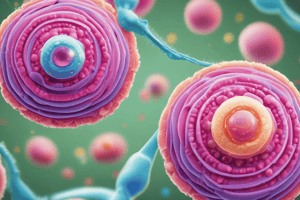Podcast
Questions and Answers
What is the primary function of the ovaries?
What is the primary function of the ovaries?
- To produce milk for the newborn
- To transport the fertilized egg to the uterus
- To provide a passageway for intercourse
- To produce female gametes (oocytes) and hormones (correct)
Which structure in the ovary is responsible for the final stage of oocyte maturation?
Which structure in the ovary is responsible for the final stage of oocyte maturation?
- Ovarian cortex (correct)
- Tunica albuginea
- Germinal epithelium
- Ovarian medulla
What is the primary role of estrogen secreted by the ovaries?
What is the primary role of estrogen secreted by the ovaries?
- To inhibit the development of sperm
- To stimulate the growth of the uterine lining (correct)
- To produce milk for the newborn
- To facilitate the transport of the fertilized egg
What is the function of the corpus luteum?
What is the function of the corpus luteum?
Which hormone is responsible for triggering ovulation?
Which hormone is responsible for triggering ovulation?
What is the role of the follicles in the ovary?
What is the role of the follicles in the ovary?
What is the first stage of follicular development?
What is the first stage of follicular development?
What triggers the final division of chromosomal material in the secondary oocyte, leading to the formation of a zygote?
What triggers the final division of chromosomal material in the secondary oocyte, leading to the formation of a zygote?
What is the function of the corpus luteum?
What is the function of the corpus luteum?
During which stage of the menstrual cycle does the corpus luteum form?
During which stage of the menstrual cycle does the corpus luteum form?
What is the primary function of estrogen during the menstrual cycle?
What is the primary function of estrogen during the menstrual cycle?
What is the main difference between oogonia and primary oocytes?
What is the main difference between oogonia and primary oocytes?
What is the primary function of the granulosa cells in the mature follicle?
What is the primary function of the granulosa cells in the mature follicle?
Which of the following is the correct sequence of events during oogenesis?
Which of the following is the correct sequence of events during oogenesis?
What is the primary role of the corpus luteum during the reproductive cycle?
What is the primary role of the corpus luteum during the reproductive cycle?
What is the main function of the zona pellucida surrounding the primary oocyte?
What is the main function of the zona pellucida surrounding the primary oocyte?
What is the primary function of the theca cells in the mature follicle?
What is the primary function of the theca cells in the mature follicle?
How do the levels of estrogen change during the menstrual cycle?
How do the levels of estrogen change during the menstrual cycle?
What is the primary function of the fimbriae at the end of the fallopian tube?
What is the primary function of the fimbriae at the end of the fallopian tube?
What is the primary role of the uterine tube (fallopian tube) in the reproductive process?
What is the primary role of the uterine tube (fallopian tube) in the reproductive process?
What is the main function of the corpus luteum after ovulation?
What is the main function of the corpus luteum after ovulation?
How does the presence of the corpus luteum affect the levels of estrogen and progesterone during the menstrual cycle?
How does the presence of the corpus luteum affect the levels of estrogen and progesterone during the menstrual cycle?
Flashcards
Ovaries
Ovaries
The female reproductive organ that produces oocytes (eggs) and hormones, primarily estrogen and progesterone.
Ovarian Cortex
Ovarian Cortex
The outer layer of the ovary where the oocytes develop and mature.
Estrogen
Estrogen
The main hormone produced by the ovaries responsible for stimulating the growth of the uterine lining and secondary sexual characteristics.
Corpus Luteum
Corpus Luteum
Signup and view all the flashcards
Luteinizing Hormone (LH)
Luteinizing Hormone (LH)
Signup and view all the flashcards
Follicles
Follicles
Signup and view all the flashcards
Primordial Follicle
Primordial Follicle
Signup and view all the flashcards
Fertilization
Fertilization
Signup and view all the flashcards
Progesterone
Progesterone
Signup and view all the flashcards
Ovulatory Phase
Ovulatory Phase
Signup and view all the flashcards
Estrogen during the Menstrual Cycle
Estrogen during the Menstrual Cycle
Signup and view all the flashcards
Oogonia
Oogonia
Signup and view all the flashcards
Primary Oocytes
Primary Oocytes
Signup and view all the flashcards
Granulosa Cells
Granulosa Cells
Signup and view all the flashcards
Oogenesis
Oogenesis
Signup and view all the flashcards
Corpus Luteum During the Cycle
Corpus Luteum During the Cycle
Signup and view all the flashcards
Zona Pellucida
Zona Pellucida
Signup and view all the flashcards
Theca Cells
Theca Cells
Signup and view all the flashcards
Estrogen Levels During the Cycle
Estrogen Levels During the Cycle
Signup and view all the flashcards
Fimbriae
Fimbriae
Signup and view all the flashcards
Uterine Tube (Fallopian Tube)
Uterine Tube (Fallopian Tube)
Signup and view all the flashcards
Corpus Luteum After Ovulation
Corpus Luteum After Ovulation
Signup and view all the flashcards
Corpus Luteum's Effects on Hormones
Corpus Luteum's Effects on Hormones
Signup and view all the flashcards




